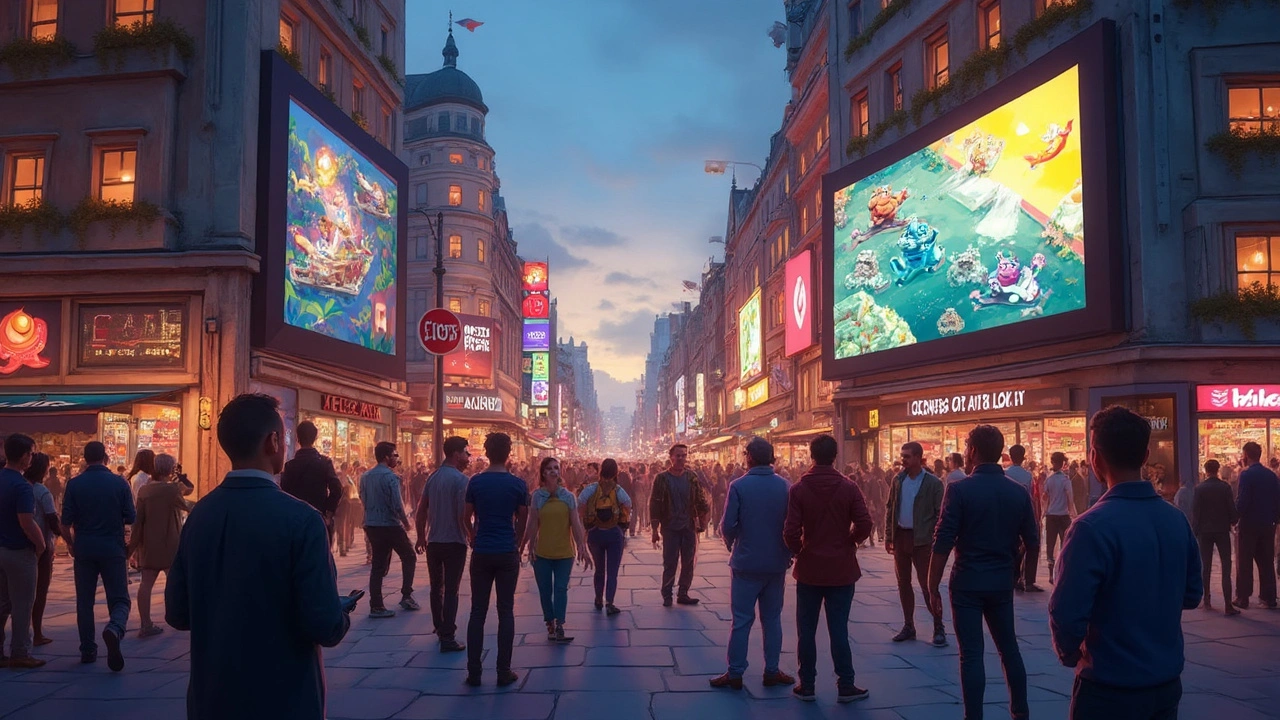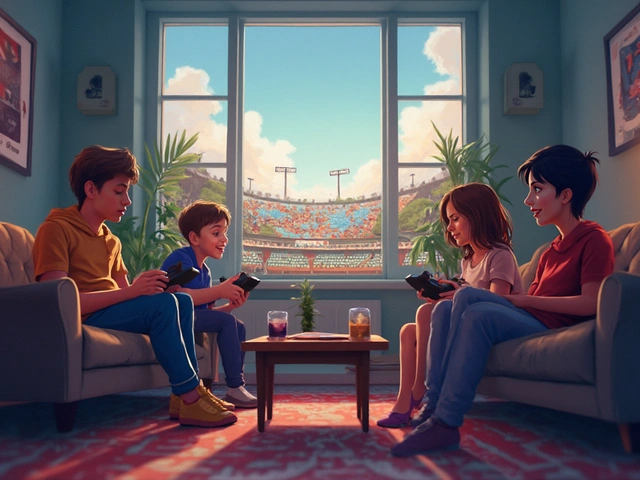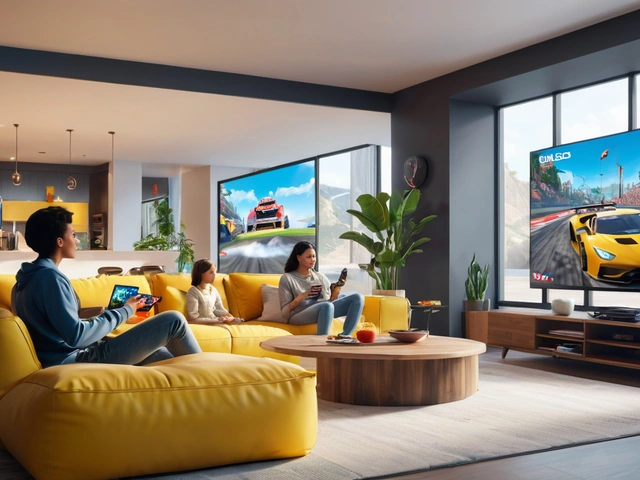Think ads are only those boring banners at the edge of your screen? Not anymore. In-game ads are popping up everywhere—on a soccer field billboard in FIFA, as radio spots in Grand Theft Auto, or even as crunchy snacks your game character munches on. You’re not just seeing ads, you’re interacting with them as part of your play.
The crazy part? These aren’t just for show. Brands actually love how deeply their message sinks in when it’s tied to your gaming session. Some studies show interactive ads in games can boost brand recall by over 30% compared to old-school digital ads. Why? Because you’re not clicking past them—you’re living with them, even if it's just for a round or two.
But here’s the catch: not all players welcome these ads. If they’re tossed in without care, they’ll stick out like a sore thumb. That’s why the smartest game developers get sneaky—they make ads as natural as the grass in a racing game. The best ones don’t break your flow; they fit right in. If you’re making a game, you have to balance getting that ad revenue with not annoying your players. The trick? Make ads interactive or give gamers control over what they see.
- How In-Game Ads Work Now
- Why Brands Are Diving Into Game Ads
- What Gamers Really Think About In-Game Ads
- Best Practices for Developers
- Tips for Gamers: Dealing with In-Game Ads
How In-Game Ads Work Now
Back in the day, in-game ads were mostly just static billboards or random product placements. Now, it’s more dynamic and targeted than ever before. Ad tech has caught up with gaming, making the ads actually feel like a part of the game, not just pasted on.
Basically, when you load up a game today—especially free-to-play mobile or PC titles—the game connects to ad servers, just like websites do. These servers pick which ads show up based on things like your location, game genre, or even your in-game behavior. Ad networks like Anzu, Bidstack, and Adverty have made it possible to place live, rotating ads into virtual spaces. So, the Coke ad on a racing circuit in London can be entirely different from the ad a player sees in Tokyo.
Types of in-game ads you'll notice most:
- Static placements: Think billboards, posters, or branded products that stay put. Easy to slip into sports, racing, or open-world games.
- Dynamic ads: These rotate and update in real time. If there’s an upcoming movie, you might see its trailer inside the world for a week, then something else pops up.
- Rewarded ads: Players can choose to watch a short ad (maybe for sneakers or soda) in exchange for a bonus, extra life, or in-game cash. Popular in mobile games like Subway Surfers and Clash of Clans.
- Interactive ads: Players actually engage, maybe by customizing a virtual item or participating in a branded challenge. Engagement rates for these jump way above typical web banners.
Here’s a look at how often these different ad types show up in games now:
| Ad Type | Common In | Player Engagement |
|---|---|---|
| Static | AAA Sports & Racing | Low |
| Dynamic | Mobile, Simulation | Medium |
| Rewarded | Mobile & Free-to-Play | High |
| Interactive | Events, Branded Mini-Games | Very High |
If you’re a gamer, you might not even notice some ads anymore. They blend in, and game publishers are careful not to mess with your experience—most of the time. But, for brands and developers, targeting these ads based on real-time data means more relevant, less annoying pitches. That's why interactive advertising in games is getting smarter by the month.
Why Brands Are Diving Into Game Ads
There's a good reason you’re seeing more in-game ads these days: brands are realizing that games are where people actually spend their time. The gaming industry is now worth more than movies and music combined, pulling in over $180 billion a year. Games reach everyone—kids on mobile, parents playing puzzle games, and hardcore fans glued to their consoles. If you’re a brand, that’s an audience you just can’t ignore.
One big win for brands? The level of attention. In-game ads sit right inside the action, so players are way more likely to remember them compared to pop-ups or banner ads. A 2023 report from Newzoo showed that ad engagement in games can be up to 2X higher than with regular digital ads. That means companies aren’t tossing their money down the drain—they’re getting eyeballs and actual interest.
Another reason for this gold rush? Games can target ads super precisely. Game publishers know what players like—from the car they drive in a racing game to how many hours they play each week. Brands use that info to get ads in front of the right people, avoiding wasted cash on folks who don’t care. Plus, interactive ads let players choose how they engage. Watch a 30-second video and get free coins? Sure, sounds better than staring at a loading screen.
Check out the kind of brands making moves here:
- Fast food chains putting their latest burger on virtual billboards.
- Shoe companies dropping limited-edition sneakers inside basketball games.
- Movie studios showing trailers as cutscenes between levels.
And it works. According to a recent Admix study, 70% of gamers say they're cool with in-game ads if it means extra content or rewards in return. This keeps everyone happy—players get freebies, brands get seen, and game makers earn money to keep the lights on.
| Industry | Example of In-Game Ad |
|---|---|
| Sportswear | Sneaker drops in NBA 2K |
| Fast Food | Drive-thru signs in racing games |
| Automotive | Branded cars in open-world games |
| Streaming Services | Promo banners in mobile puzzle games |
Bottom line: interactive advertising in games isn’t just a passing trend. Brands are here to stay, and they’re making the experience more engaging—for better or worse.

What Gamers Really Think About In-Game Ads
Gamers have a love-hate thing with in-game ads. Some totally get that they help keep their favorite games free or fuel cooler updates, but nobody wants an ad breaking up a boss fight. The biggest gripe isn't the presence of ads—it's when they're shoved at you at the worst possible moments, killing the buzz or blocking progress. People especially can't stand it when you have to watch a 30-second spot just to get new lives or unlock a basic feature.
Oddly enough, not all ads tick off gamers. When ads actually fit the game world or give something back—like a reward, skin, or powerup—attitudes change fast. Think about racing games with real car brands or adventure titles that toss in snack brands as background details. It feels less like advertising and more like world-building. Most players don’t mind these as long as the brands don’t scream for attention.
Players are also getting wise to how much data they trade for those seemingly harmless ads. Privacy is actually a big deal, especially when mobile interactive advertising tracks habits. A 2024 gaming insights report found that 67% of mobile gamers want clear options to control their ad experience, including skipping or opting out of personalized ads.
| Ad Type | Gamer Acceptance Rate |
|---|---|
| Rewarded Video | 72% |
| Native/Banner Ads | 39% |
| Unskippable Video | 21% |
| Integrated Branded Content | 63% |
The big takeaway? Gamers hate feeling tricked or interrupted, but they’re cool with game monetization if it respects their time and doesn’t get in the way. If a developer lets players skip, mute, or pick what kind of ads they see, it’s a win for everyone. Listening to gamer feedback isn’t just good manners—it’s good business.
Best Practices for Developers
Nailing in-game ads isn’t just about slapping a brand logo somewhere. It takes smart planning and a real feel for what players want. Insert ads the wrong way, and you’ll have players rage-quitting faster than you can count your ad revenue. So how do you place ads that get clicks but don’t ruin the fun?
- Blend Ads Seamlessly: Every ad should feel like it belongs. Stick to ad formats that match your game's style—like billboards in a racing game or branded drinks at an in-game cafe. Gameloft did this well in Asphalt 9, letting brands like Porsche sponsor in-game events that actually made sense for players.
- Go Interactive: Static banners are out. Interactive game ads—think playable mini-ads or unlockable branded items—get more attention. Playable ads can boost engagement by 40%, according to a report from ironSource. Players aren’t just watching; they’re clicking, tapping, and sometimes even competing for in-game rewards.
- Respect Player Choice: Give players some level of control over ad experience. Offer rewards for watching full ads, or let them opt out of certain ad types. Rewarded video ads in games like Candy Crush keep players happy because they feel like they’re getting something back—a real win-win.
- Don’t Disrupt the Gameplay: Interrupting action for an ad is a fast way to lose fans. Time your ad breaks thoughtfully—use natural pauses, like between levels or rounds. You want your advertising to feel like background, not a roadblock.
- Measure and Adjust: Track which ads work, which annoy, and which get ignored. Use analytics and player feedback to tweak placements. Casual games like Subway Surfers regularly change ad formats based on what players respond to best.
Here’s a quick look at how interactive ads stack up against regular old banners:
| Ad Type | Click-Through Rate | Player Satisfaction |
|---|---|---|
| Banner Ads | 0.3% | Low |
| Playable/Interactive Ads | 2%+ | Medium to High |
Bottom line? Think about the player first. Make every ad feel like a natural part of the game, and you’ll keep both your community and your advertisers happy.

Tips for Gamers: Dealing with In-Game Ads
If you feel like ads are everywhere in games lately, you’re not imagining it. In-game ads are a big part of how free-to-play titles make money, and even paid games sometimes sneak them in. But you don’t have to just deal with whatever gets thrown at you—there are ways to make things less annoying.
- Go premium or pay to remove ads: Lots of mobile games offer a one-time payment (sometimes $1–$5) to ditch ads completely. If you play a game a lot, it’s often worth it for a smoother experience.
- Limit app tracking permissions: Both iOS and Android let you control ad tracking. Turning this off in your settings can mean less targeted, sometimes less frequent ads.
- Check for ad-free modes: Some games offer offline or "practice" modes without in-game ads. Give those a try if you’re just looking to chill for a bit.
- Mute the volume: Got an unskippable ad? Muting your device makes those long 30-second ones less painful. A small thing, but it helps.
- Look for community mods: On PC, some single-player games have mods that cut out advertising—though use these at your own risk and never on online games to avoid bans.
- Use family or kids modes: Platforms like Roblox and Minecraft offer parental controls that can limit exposure to certain types of interactive advertising.
Here’s a quick rundown. Notice how often basic actions can lower your ad exposure:
| Tip | How Effective? |
|---|---|
| Pay to remove ads | Very effective (removes all in most apps) |
| Disable tracking | Moderately effective (less personal ads) |
| Ad-free modes | Effective for casual play |
| Use mods (PC only) | Varies—check for safety first |
Don’t forget: if you ever feel like ads are getting out of hand, leave feedback through the game’s support option. Developers actually pay attention to this, and sometimes tweak how ads in games work if enough players complain. You don’t have to just accept annoying ads—there’s often something you can do about them.




Write a comment